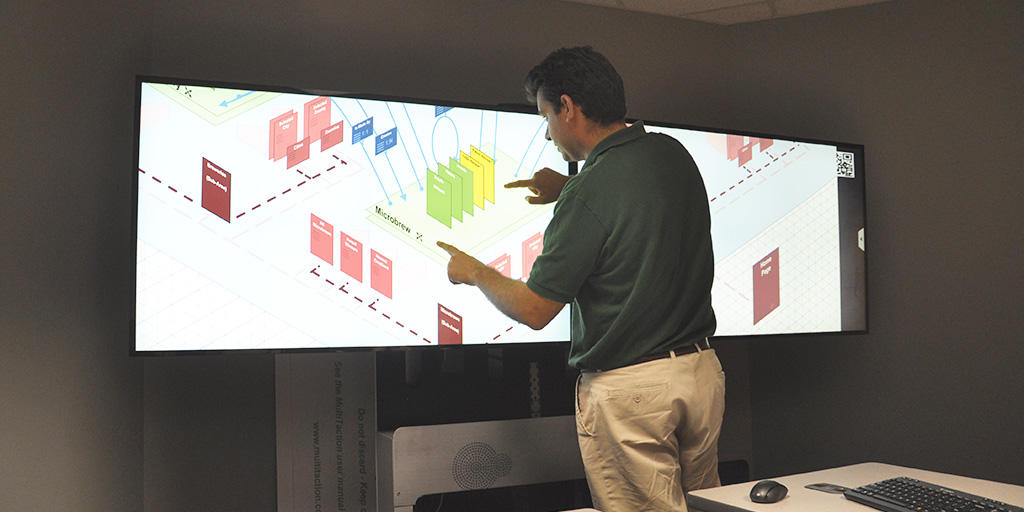ABSTRACT
Users are fundamental to HCI. However, little is known about how HCI education introduces students to working with users, particularly those different from themselves. To better understand design students’ engagement, reactions, and reflections with users, we investigate a case study of a graduate-level 10-week prototyping studio course that partnered with a children’s co-design team. HCI students participated in two co-design sessions with children to design a STEM learning experience for youth. We conducted participant observations, interviews with 14 students, and analyzed final artifacts. Our findings demonstrate the communication challenges and strategies students experienced, how students observed issues of power dynamics, and students’ perceived value in engaging with users. We contribute empirical evidence of how HCI students directly interact with target users, principles for reflective HCI pedagogy, and highlight the need for a more intentional investigation into HCI educational practice.
Author Keywords
HCI education, User-centered design, Reflection
CSS Concepts
Human-centered computing-Human computer interaction (HCI)
INTRODUCTION
Involving users throughout the design process is a key tenet of HCI research and practice [78, 105]—even the terms “user-experience” (UX) and “user-centered design” reflect this focus. Consequently, HCI pedagogy emphasizes the need for students to be exposed to and directly work with users in authentic design settings [23, 24, 58, 78]. Surprisingly, little research has been conducted on how HCI students interact with users, particularly those different from themselves. While rich literature exists on user-centered design and evaluation methods such as participatory design (PD) [9, 42, 62, 63, 65, 68, 72, 98], design probes [53, 55], and online technologies [4, 56], prior work has not explored how to operationalize these findings into educational practice within the constraints of an academic HCI course.
Recently, HCI educators have begun to reflect more on pedagogy and practice [105]. One way for students to practice their design skills is through studio-based learning approaches [29, 45, 58, 83, 93, 101]. Existing HCI courses often ask students to find and work with users to ideate, test and iterate on their design projects [77]. From our own experiences as HCI educators and prior work [52], we know that students often select users with convenience sampling [73] (e.g., their roommates, peers, neighbors, and friends from social media). This is a challenge for HCI education because students need to learn how to work with a wide range of users [24]. But how do (and should) HCI educators prepare students for this task? And what challenges do HCI students encounter in their design process?
To better understand how Human-Computer Interaction students engaged with, reacted to, and reflected on working with users in their design process, we integrated a children’s co-design team with a master’s student (MS) HCI prototyping studio course. We refer to “co-design” as the involvement of end-users as part of the PD process [33, 34]. In the 10-week course, graduate students worked in teams to iteratively design and build a low-cost physical computing “STEM learning” experience and an accompanying lesson plan for 3rd-6th graders. Each design team participated in two co-design sessions with children using Cooperative Inquiry, a PD method focused on children as design partners with adults [33]. Our core contribution is not to study how to incorporate co-design methods into the classroom but rather to document and offer guidelines about how to incorporate users from different backgrounds into our HCI teaching practices.
In our research, we were specifically interested in two key questions: RQ1. How do HCI students engage with users unlike themselves during their design process? and RQ2. What value do HCI students perceive in working with users different from themselves in their design and reflection process? To address these questions, we drew upon three sources of data: video recordings from eight 90-minute codesign sessions, semi-structured interviews with a subset of HCI students after the course ended (n = 14), and artifacts from final project documentation. For the interviews, we asked questions about how students prepared for and experienced the co-design sessions, challenges and concerns, and advice for future HCI students. We also showed video clips of their co-design sessions and asked students to talk about and to reflect on their interactions with the children. Following the interviews, we collected and analyzed final project artifacts from seven participating students. We triangulated across our data to analyze the co-design sessions, collect personal accounts from the students, and to better understand how design decisions were influenced by the co-design sessions.
Our findings reveal how design students communicated with their users and challenges therein, the complex role of power dynamics between designer, user, Human-Computer Interaction student, and other course stakeholders (e.g., the educator), and how the student’s perceived value in working with users through reflection. Our work shows the need for more intentional focus and investigation on HCI pedagogy, such as how HCI students build rapport with their users or how they navigate complex power dynamics when engaging with users and facilitators. Overall, we make three contributions to the HCI community:
1. Empirically, we uncover the nuances and complexities of HCI students engaging users unlike themselves in their design process, thereby uncovering the design complexity [96] between designers and users.
2. Theoretically, we extend Sengers et al.’s [84] notion of reflective practices in HCI pedagogy and education.
3. We provide recommendations for reflective practices on student engagement with users in HCI education.
CONCLUSION AND FUTURE WORK
HCI education programs across the world have grown dramatically, moving from single fields (e.g., computer science) toward multidisciplinary and transdisciplinary spaces. While HCI education has paid much attention to user-centric engagement, primarily in the form of methods or strategies, there is a great need for HCI students to engage and develop knowledge of working with users (in the form of soft skills and experiential knowledge) that comes about in actual design practice in complex situations. Students not understanding or appreciating the importance of these skillsets early in their development can create situations where they face conflict or become unreflective designers. This investigation and its rich descriptions of HCI students’ engagement with users unlike themselves point to the need for future work to investigate other designer-user situations to help our community recognize the design complexities that exist in such interactions. Overall, we believe there is great potential in the creation of reflective pedagogical practices to develop HCI students that enter the world, not shying away from messy reality, but facing it head-on with the right skills and attitudes.
About KSRA
The Kavian Scientific Research Association (KSRA) is a non-profit research organization to provide research / educational services in December 2013. The members of the community had formed a virtual group on the Viber social network. The core of the Kavian Scientific Association was formed with these members as founders. These individuals, led by Professor Siavosh Kaviani, decided to launch a scientific / research association with an emphasis on education.
KSRA research association, as a non-profit research firm, is committed to providing research services in the field of knowledge. The main beneficiaries of this association are public or private knowledge-based companies, students, researchers, researchers, professors, universities, and industrial and semi-industrial centers around the world.
Our main services Based on Education for all Spectrum people in the world. We want to make an integration between researches and educations. We believe education is the main right of Human beings. So our services should be concentrated on inclusive education.
The KSRA team partners with local under-served communities around the world to improve the access to and quality of knowledge based on education, amplify and augment learning programs where they exist, and create new opportunities for e-learning where traditional education systems are lacking or non-existent.
FULL Paper PDF file:
Opportunities and Challenges in Involving Users in Project-Based HCI EducationBibliography
author
Year
2020
Title
Opportunities and Challenges in Involving Users in Project-Based HCI Education
Publish in
Proceedings of the 2020 CHI Conference on Human Factors in Computing Systems
Doi
https://doi.org/10.1145/3313831.3376530
PDF reference and original file: Click here
Nasim Gazerani was born in 1983 in Arak. She holds a Master's degree in Software Engineering from UM University of Malaysia.
- Nasim Gazeranihttps://ksra.fr/author/nasim/
- Nasim Gazeranihttps://ksra.fr/author/nasim/
- Nasim Gazeranihttps://ksra.fr/author/nasim/
- Nasim Gazeranihttps://ksra.fr/author/nasim/
Professor Siavosh Kaviani was born in 1961 in Tehran. He had a professorship. He holds a Ph.D. in Software Engineering from the QL University of Software Development Methodology and an honorary Ph.D. from the University of Chelsea.
- siavosh kavianihttps://ksra.fr/author/ksadmin/
- siavosh kavianihttps://ksra.fr/author/ksadmin/
- siavosh kavianihttps://ksra.fr/author/ksadmin/
- siavosh kavianihttps://ksra.fr/author/ksadmin/
Somayeh Nosrati was born in 1982 in Tehran. She holds a Master's degree in artificial intelligence from Khatam University of Tehran.
- Somayeh Nosratihttps://ksra.fr/author/somayeh/
- Somayeh Nosratihttps://ksra.fr/author/somayeh/
- Somayeh Nosratihttps://ksra.fr/author/somayeh/
- Somayeh Nosratihttps://ksra.fr/author/somayeh/





